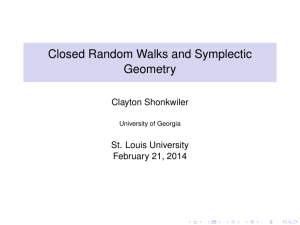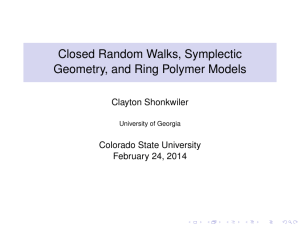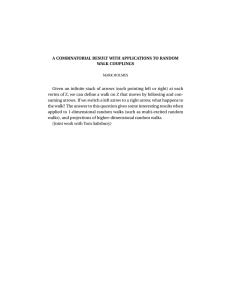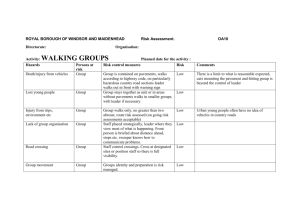Closed Random Walks and Symplectic Geometry Clayton Shonkwiler Cal State Fullerton
advertisement
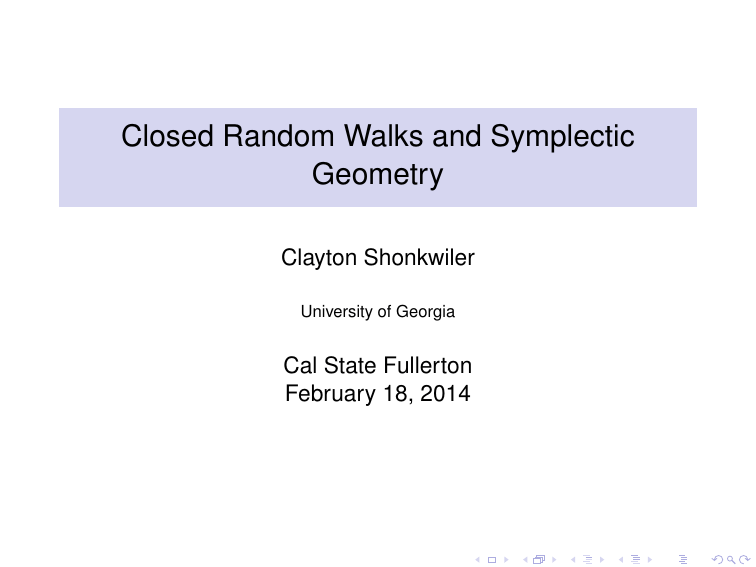
Closed Random Walks and Symplectic
Geometry
Clayton Shonkwiler
University of Georgia
Cal State Fullerton
February 18, 2014
Random Walks (and Polymer Physics)
Physics Question
What is the average shape of a polymer in solution?
Protonated P2VP
Roiter/Minko
Clarkson University
Plasmid DNA
Alonso-Sarduy, Dietler Lab
EPF Lausanne
Random Walks (and Polymer Physics)
Physics Question
What is the average shape of a polymer in solution?
Physics Answer
Modern polymer physics is based on the analogy
between a polymer chain and a random walk.
—Alexander Grosberg, NYU.
Random Walks
Let Arm(n) be the moduli space of random walks in R3
consisting of n unit-length steps up to translation.
Then Arm(n) ∼
= S 2 (1) × . . . × S 2 (1).
{z
}
|
n
Random Walks
Let Arm(n) be the moduli space of random walks in R3
consisting of n unit-length steps up to translation.
Then Arm(n) ∼
= S 2 (1) × . . . × S 2 (1).
{z
}
|
n
Let Pol(n) ⊂ Arm(n) be the submanifold of closed random
walks (or random polygons); i.e., those walks which satisfy
n
X
i=1
~ei = ~0.
A Random Walk with 3,500 Steps
A Closed Random Walk with 3,500 Steps
Classical Problems
• What is the joint distribution of steps in a closed walk?
Classical Problems
• What is the joint distribution of steps in a closed walk?
• What can we prove about closed random walks?
• What is the marginal distribution of a single chord length?
• What is the joint distribution of several chord lengths?
• What is the expectation of radius of gyration?
• What is the expectation of total curvature?
Classical Problems
• What is the joint distribution of steps in a closed walk?
• What can we prove about closed random walks?
• What is the marginal distribution of a single chord length?
• What is the joint distribution of several chord lengths?
• What is the expectation of radius of gyration?
• What is the expectation of total curvature?
• How do we sample closed equilateral random walks?
• What if the walk is confined to a sphere? (Confined DNA)
• Can we get error bars?
Classical Problems
• What is the joint distribution of steps in a closed walk?
• What can we prove about closed random walks?
• What is the marginal distribution of a single chord length?
• What is the joint distribution of several chord lengths?
• What is the expectation of radius of gyration?
• What is the expectation of total curvature?
• How do we sample closed equilateral random walks?
• What if the walk is confined to a sphere? (Confined DNA)
• Can we get error bars?
Point of Talk
New sampling algorithms backed by deep and robust
mathematical framework. Guaranteed to converge, relatively
easy to code.
(Incomplete?) History of Sampling Algorithms
• Markov Chain Algorithms
• crankshaft (Vologoskii 1979, Klenin 1988)
• polygonal fold (Millett 1994)
• Direct Sampling Algorithms
• triangle method (Moore 2004)
• generalized hedgehog method (Varela 2009)
• sinc integral method (Moore 2005, Diao 2011)
(Incomplete?) History of Sampling Algorithms
• Markov Chain Algorithms
• crankshaft (Vologoskii et al. 1979, Klenin et al. 1988)
• convergence to correct distribution unproved
• polygonal fold (Millett 1994)
• convergence to correct distribution unproved
• Direct Sampling Algorithms
• triangle method (Moore et al. 2004)
• samples a subset of closed polygons
• generalized hedgehog method (Varela et al. 2009)
• unproved whether this is correct distribution
• sinc integral method (Moore et al. 2005, Diao et al. 2011)
• requires sampling complicated 1-d polynomial densities
Fold Moves
Definition
A fold move or bending flow rotates an arc of the polygon
around the axis determined by its endpoints.
The polygonal fold Markov chain selects arcs and angles at
random and folds repeatedly.
New Idea: Dihedral Angle Moves
Definition
Given an (abstract) triangulation of the n-gon, the folds on any
two chords commute. A dihedral angle move rotates around all
of these chords by independently selected angles.
The Triangulation Polytope
Definition
A abstract triangulation T of the n-gon picks out n − 3
nonintersecting chords. The lengths of these chords obey
triangle inequalities, so they lie in a convex polytope in Rn−3
called the triangulation polytope P.
2
1
0
0
1
2
The Triangulation Polytope
Definition
A abstract triangulation T of the n-gon picks out n − 3
nonintersecting chords. The lengths of these chords obey
triangle inequalities, so they lie in a convex polytope in Rn−3
called the triangulation polytope P.
(2, 3, 2)
(0, 0, 0)
(2, 1, 0)
Action-Angle Coordinates
Definition
If P is the triangulation polytope and T n−3 is the torus of n − 3
dihedral angles, then there are action-angle coordinates:
α : P × T n−3 → Pol(n)/ SO(3)
14
✓2
d1
d2
✓1
c
~
Main Theorem
Theorem (with Cantarella)
α pushes the standard probability measure on P × T n−3
forward to the correct probability measure on Pol(n)/ SO(3).
Main Theorem
Theorem (with Cantarella)
α pushes the standard probability measure on P × T n−3
forward to the correct probability measure on Pol(n)/ SO(3).
Ingredients of the Proof.
Kapovich–Millson toric symplectic structure on polygon space +
Duistermaat–Heckman theorem + Hitchin’s theorem on
compatibility of Riemannian and symplectic volume on
symplectic reductions of Kähler manifolds +
Howard–Manon–Millson analysis of polygon space.
Greg Kuperberg∗
Department of Mathematics, University of California, Davis, CA 95616
An Explanation by Analogy
Dedicated to Krystyna Kuperberg on the occasion of her 60th birthday
imedes’ hat-box theorem states that uniform measure on a sphere projects to uniform measure on an
. This fact can be used to derive Simpson’s rule. We present various constructions of, and lower bounds
merical cubature formulas using moment maps as a generalization of Archimedes’ theorem. We realize
well-known cubature formulas on simplices as projections of spherical designs. We combine cubature
as on simplices and tori to make new formulas on spheres. In particular Sn admits a 7-cubature formula
mes a 7-design) with O(n4 ) points. We establish a local lower bound on the density of a PI cubature
a on a simplex using the moment map.
2
g the way we establish other quadrature
and cubature results of independent interest. For each t, we
ct a lattice trigonometric (2t + 1)-cubature formula in n dimensions with O(nt ) points. We derive a
of the Möller lower bound using vector bundles. And we show that Gaussian quadrature is very sharply
optimal among positive quadrature formulas.
1.
Theorem (Archimedes, Duistermaat–Heckman)
Let f : S → R be given by (x, y , z) 7→ z. Then the pushforward
of the standard measure on the sphere to the interval is 2π
times Lebesgue measure.
INTRODUCTION
it.) Therefore if F is a t-cubature formula on S2 , its projection
π (F) is a t-cubature formula on [−1, 1].
e on Rn with finite moments. A cubature
or µ is a set of points F = {!pa } ⊂ Rn and
#→ wa ∈ R such that
def
d µ = P(F) =
N
∑ wa P(!pa)
π
a=1
degree at most t. (If n = 1, then F is also
formula.) The formula F is equal-weight
ositive if all wa are positive; and negative
negative. Let X be the support of µ . The
r if every point !pa is in the interior of X;
ry !pa is in X and some !pa is in ∂ X; and
or. We will mainly consider positive, inve, boundary (PB) cubature formulas, and
that µ is normalized so that total measure
re the most useful in numerical analysis
plication also motivates the main question
s, which is to determine how many points
Illustration
by Kuperberg.
Figure 1: Archimedes’ hat-box theorem.
The 2-sphere S2 has 5 especially nice cubature formulas
given by the vertices of the Platonic solids. Their cubature properties follow purely from a symmetry argument of
Sobolev [25]. Suppose that G is the group of common sym-
Action-Angle Coordinates are Cylindrical Coordinates
(z, θ)
√
√
( 1 − z 2 cos θ, 1 − z 2 sin θ, z)
Corollary
This map pushes the standard probability measure on
[−1, 1] × S 1 forward to the correct probability measure on S 2 .
Action-Angle Coordinates are Cylindrical Coordinates
(z, θ)
√
√
( 1 − z 2 cos θ, 1 − z 2 sin θ, z)
Corollary
More generally, the standard probability measure on
[−1, 1]n × T n pushes forward to the correct probability measure
on (S 2 )n = Arm(n).
Main Theorem Repeated
Theorem (with Cantarella)
α pushes the standard probability measure on P × T n−3
forward to the correct probability measure on Pol(n)/ SO(3).
Corollary
Any sampling algorithm for convex polytopes is a sampling
algorithm for closed equilateral polygons.
Corollary
The expectation of any function of a collection of
non-intersecting chordlengths can be computed by integrating
over the triangulation polytope.
Expectations of Chord Lengths
Theorem (with Cantarella)
The expected length of a chord skipping k edges in an n-edge
closed equilateral random walk is the (k − 1)st coordinate of
the center of mass of the triangulation polytope for Pol(n).
n\k
2
4
1
5
17
15
14
12
461
385
1,168
960
112,121
91,035
97,456
78,400
6
7
8
9
10
3
4
5
6
7
8
17
15
15
12
506
385
1,307
960
127,059
91,035
111,499
78,400
14
12
506
385
1,344
960
133,337
91,035
118,608
78,400
461
385
1,307
960
133,337
91,035
120,985
78,400
1,168
960
127,059
91,035
118,608
78,400
112,121
91,035
111,499
78,400
97,456
78,400
A Bound on Knot Probability
Theorem (with Cantarella)
At least 1/2 of six-step closed random walks are unknotted.
Proof.
Using a result of Calvo, the possible dihedral angles of a
knotted hexagon comprise no more than half of the torus of
dihedrals.
A Markov Chain for Convex Polytopes
Recall
Action-angle coordinates reduce sampling closed random
walks to the (solved) problem of sampling a convex polytope.
A Markov Chain for Convex Polytopes
Recall
Action-angle coordinates reduce sampling closed random
walks to the (solved) problem of sampling a convex polytope.
Definition (Hit-and-run Sampling Markov Chain)
Given ~pk ∈ P ⊂ Rn ,
1
2
3
Choose a random direction ~v uniformly on S n−1 .
Let ` be the line through ~pk in direction ~v .
Choose ~pk +1 uniformly on ` ∩ P.
A Markov Chain for Convex Polytopes
Recall
Action-angle coordinates reduce sampling closed random
walks to the (solved) problem of sampling a convex polytope.
Definition (Hit-and-run Sampling Markov Chain)
Given ~pk ∈ P ⊂ Rn ,
1
2
3
Choose a random direction ~v uniformly on S n−1 .
Let ` be the line through ~pk in direction ~v .
Choose ~pk +1 uniformly on ` ∩ P.
Theorem (Smith, 1984)
The hit-and-run Markov chain is uniformly ergodic with respect
to Lebesgue measure on P.
A (new) Markov Chain for Closed Random Walks
Definition (TSMCMC(β))
If xk = (~pk , θ~k ) ∈ P × T n−3 , define xk +1 by:
• With probability β, update ~
pk by a hit-and-run step on P.
~k with a new uniformly
• With probability 1 − β, replace θ
sampled point in T n−3 .
At each step, construct the corresponding closed random walk
α(xk ) using action-angle coordinates.
A (new) Markov Chain for Closed Random Walks
Definition (TSMCMC(β))
If xk = (~pk , θ~k ) ∈ P × T n−3 , define xk +1 by:
• With probability β, update ~
pk by a hit-and-run step on P.
~k with a new uniformly
• With probability 1 − β, replace θ
sampled point in T n−3 .
At each step, construct the corresponding closed random walk
α(xk ) using action-angle coordinates.
Proposition (with Cantarella)
TSMCMC(β) is uniformly ergodic with respect to the standard
probability measure on Pol(n)/SO(3).
Error Analysis for Integration with TSMCMC(β)
Suppose f is a function on closed random walks and
SampleMean(f ; R, m) is the average value of f over the first m
steps of a run R of TSMCMC(β).
Because TSMCMC(β) is uniformly ergodic, we have
1
w denotes weak convergence, E(f ) is the expectation of f
Error Analysis for Integration with TSMCMC(β)
Suppose f is a function on closed random walks and
SampleMean(f ; R, m) is the average value of f over the first m
steps of a run R of TSMCMC(β).
Because TSMCMC(β) is uniformly ergodic, we have
Theorem (Markov Chain Central Limit Theorem)
If f is square-integrable, there exists a real number σ(f ) so that1
√
w
m(SampleMean(f ; R, m) − E(f )) −→ N (0, σ(f )2 ),
the Gaussian with mean 0 and standard deviation σ(f )2 .
1
w denotes weak convergence, E(f ) is the expectation of f
Error Bars for TSMCMC(β) Integration
1
Run TSMCMC(β) for m steps
2
Compute SampleMean(f ; R, m)
3
Compute the Geyer IPS Estimator σ̄m (f ) for σ(f )
Then with 95% confidence the true expectation of f is
√
E(f ) = SampleMean(f ; R, m) ± 1.96σ̄m (f )/ m.
Error Bars for TSMCMC(β) Integration
1
Run TSMCMC(β) for m steps
2
Compute SampleMean(f ; R, m)
3
Compute the Geyer IPS Estimator σ̄m (f ) for σ(f )
Then with 95% confidence the true expectation of f is
√
E(f ) = SampleMean(f ; R, m) ± 1.96σ̄m (f )/ m.
Experimental Observation
With 95% confidence, we can say that the fraction of knotted
equilateral hexagons is between 1.1 and 1.5 in 10,000.
Confined Polygons
Definition
A closed random walk is in rooted spherical confinement of
radius R if each chord length is less than R. Such a polygon is
contained in a sphere of radius R centered at the first vertex.
Sampling Confined Polygons
Let PR be the subpolytope of P determined by the additional
linear conditions that each chord length is less than R.
Theorem (with Cantarella)
The action-angle map α pushes the standard probability
measure on PR × T n−3 forward to the correct probability
measure on the space of closed random walks in rooted
spherical confinement of radius R.
Many other confinement models are possible!
Expected Chordlengths for Confined 10-gons
Expected Chord Length
1.5
1.0
0.5
2
4
6
8
Confinement radii are 1.25, 1.5, 1.75, 2, 2.5, 3, 4, and 5.
10
k
Unconfined 100-gons
Unconfined 100-gons
Unconfined 100-gons
Unconfined 100-gons
20-confined 100-gons
20-confined 100-gons
20-confined 100-gons
20-confined 100-gons
10-confined 100-gons
10-confined 100-gons
10-confined 100-gons
10-confined 100-gons
5-confined 100-gons
5-confined 100-gons
5-confined 100-gons
5-confined 100-gons
2-confined 100-gons
2-confined 100-gons
2-confined 100-gons
2-confined 100-gons
1.1-confined 100-gons
1.1-confined 100-gons
1.1-confined 100-gons
1.1-confined 100-gons
Thank you!
Thank you for listening!
References
• Probability Theory of Random Polygons from the
Quaternionic Viewpoint
Jason Cantarella, Tetsuo Deguchi, and Clayton Shonkwiler
arXiv:1206.3161
Communications on Pure and Applied Mathematics
(2013), doi:10.1002/cpa.21480.
• The Expected Total Curvature of Random Polygons
Jason Cantarella, Alexander Y. Grosberg, Robert Kusner,
and Clayton Shonkwiler
arXiv:1210.6537.
• The symplectic geometry of closed equilateral random
walks in 3-space
Jason Cantarella and Clayton Shonkwiler
arXiv:1310.5924.
